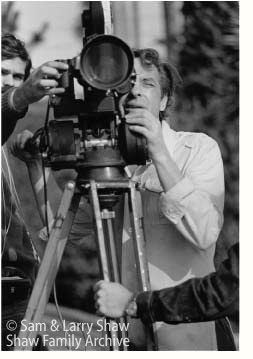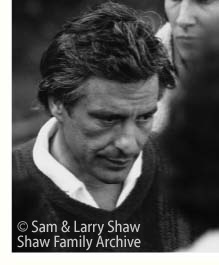|
 This
is the autobiography John Cassavetes never lived to write. In his
own
words Cassavetes tells the story of his life as he lived it, day by day,
year by year. He begins with his family and childhood experiences,
talks
about being a high-school student, college dropout and drama-school student.
He describes the years he spent pounding the pavement in New York
as a
young, unemployed actor unable to get a job – or even an agent. Then he
takes us behind the scenes to let us sit in on the planning, rehearsing,
shooting and editing of each of his films – from Shadows, Faces
and Husbands to Minnie and Moskowitz, A Woman Under
the Influence, The Killing of a Chinese Bookie, Opening
Night,
Gloria and Love Streams. He describes the struggle to get
them made, and the even greater battle to get many of them into movie
theaters. He talks about the reaction of audiences and reviewers to his
work, and responds to criticisms of it. This
is the autobiography John Cassavetes never lived to write. In his
own
words Cassavetes tells the story of his life as he lived it, day by day,
year by year. He begins with his family and childhood experiences,
talks
about being a high-school student, college dropout and drama-school student.
He describes the years he spent pounding the pavement in New York
as a
young, unemployed actor unable to get a job – or even an agent. Then he
takes us behind the scenes to let us sit in on the planning, rehearsing,
shooting and editing of each of his films – from Shadows, Faces
and Husbands to Minnie and Moskowitz, A Woman Under
the Influence, The Killing of a Chinese Bookie, Opening
Night,
Gloria and Love Streams. He describes the struggle to get
them made, and the even greater battle to get many of them into movie
theaters. He talks about the reaction of audiences and reviewers to his
work, and responds to criticisms of it.
The
opinion of Harmony Korine, writer-director of Kids, Gummo, Julian
Donkey-Boy about Ray Carney's Cassavetes on Cassavetes:
"THE
BEST FILM BOOK EVER WRITTEN."
|
The tale is
a personal, passionate one: of dreams, struggles, triumphs, setbacks
and frustrations; of hair-raising
financial gambles, crazy artistic risk-taking and midnight visions of
glory. But it is also the story of an artistic movement that extended
beyond Cassavetes and defined an era in film history. Between the lines,
as it were, these pages chronicle the history of one of the most important
artistic movements of the past fifty years – the birth and development
of American independent film-making, and the response to it by critics
and reviewers.
Cassavetes pioneered a new
conception of what film can be and do. His vision was of film as a
personal
exploration of the meaning of his life and the lives of the people around
him. It was a way of asking deep, probing questions about the world
in
which he lived, and of asking others to question and explore their own
experiences. The pages that follow trace the cultural trajectory of
that
idea, and the wildly opposed responses it elicited: the incredible energy
and excitement it engendered among certain artists, critics and viewers;
and the fierce resistance it met with from uncomprehending studio heads,
producers, distributors, reviewers and audiences fighting to hold
on to
their notion of the movies as "story-telling" or "entertainment." In
fact, the battle is far from over; it continues today.
Since this is the first time
Cassavetes' life story has been told, very few of the following facts
have been known outside of the circle of his intimate friends and family.
Many facets of the story (from Cassavetes playing "chicken" on the
Port
Washington sand-pit cliffs during his teens, to his feelings of oppression
at the narrowness and conformity of American culture when he was in
high
school, to his playwriting and repertory theater work in the final decade
of his life) will be unfamiliar even to someone who has read all of
the
standard journalistic biographies. Most of the events are appearing in
print for the first time.
To
verify the facts, I tracked down the actual participants to the events
whenever I possibly could. I conducted scores of interviews – with Cassavetes
in the final years of his life and with dozens of actors, crew members
and friends who worked with him over the years, including Peter Falk,
Ben Gazzara, Seymour Cassel, Elaine May, Lelia Goldoni, Sam Shaw, Larry
Shaw, Hugh Hurd, George O'Halloran, Al Ruban, Maurice McEndree, Ted Allan,
Lynn Carlin, Tim Carey, Erich Kollmar, Michael Ferris, Meta Shaw, Jonas
Mekas, Amos Vogel, and many others. (Many of the interviews took the form
of panel discussions or post-screening question-and-answer sessions I
organized and moderated at film festivals.) Over the time it took to complete
the project, the original interviews were supplemented with hundreds of
hours of follow-up telephone conversations, e-mails and handwritten notes,
memoirs and recollections provided by these figures and others, which
were incorporated into the narrative.
My hope is that this will
be a book with surprises and discoveries on nearly every page, even
for someone
who may already be a Cassavetes "buff." I have written four books and
dozens of essays and program notes about the films, and yet was astonished
to discover something new about Cassavetes' life or work almost every
single day I worked on this project. Many of the facts I uncovered
turned
the common wisdom about his life, the accepted truths about how the movies
were made, upside down and inside out.
 One
of the most striking things that emerged for me personally was the realization
of the degree to which Cassavetes' films were quarried from his most private
feelings and experiences – far beyond what I had imagined when I began.
Cassavetes is in his films, and his feelings about life are in characters
like Shadows' Ben, Faces' Richard, Minnie and Moskowitz's
Seymour, A Woman Under the Influence's Mabel, The Killing of
a Chinese Bookie's Cosmo and Love Streams' Robert – to an extent
that stunned me when I ultimately grasped it. I hope that one of the functions
of this book will be to help us understand Cassavetes' work, and the work
of artistic creation in general, in new ways. We need to rethink the films
in the light of the secrets Cassavetes reveals in these pages. One
of the most striking things that emerged for me personally was the realization
of the degree to which Cassavetes' films were quarried from his most private
feelings and experiences – far beyond what I had imagined when I began.
Cassavetes is in his films, and his feelings about life are in characters
like Shadows' Ben, Faces' Richard, Minnie and Moskowitz's
Seymour, A Woman Under the Influence's Mabel, The Killing of
a Chinese Bookie's Cosmo and Love Streams' Robert – to an extent
that stunned me when I ultimately grasped it. I hope that one of the functions
of this book will be to help us understand Cassavetes' work, and the work
of artistic creation in general, in new ways. We need to rethink the films
in the light of the secrets Cassavetes reveals in these pages.
This
page only contains excerpts and selected passages from Ray Carney's writing
about John Cassavetes. To obtain the complete text as well as the complete
texts of many pieces about Cassavetes that are not included on the web
site, click
here.
|









